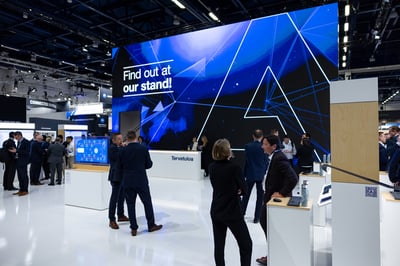If you’re keen to know how to get the best of professional radio and combine it with all the advantages of modern smartphone apps, you’ve come to the right place.
Over the last three years, visitors to our website have been telling us about their biggest challenges when buying radios. One of the most common topics was about how to combine TETRA and 4G/5G. Inspired by that, I present “17 questions and answers about dual-mode TETRA and broadband devices”.
Although some of these questions may seem similar, they focus on providing specific answers to the actual questions our website visitors asked. It’s what professionals really want to know about hybrid devices.
1 - How do TETRA radios compare with 4G/5G devices?
Reliable, secure group communication is the key feature of TETRA radios which millions of professionals rely on every day. TETRA radio communication was originally designed for making calls to a group of people quickly and easily using only one button, hence the name “push-to-talk”. Another essential design feature is secure and reliable messaging on the same device.
In addition, professional devices and their user interface must be easy to use in critical situations, in the dark, without looking at the display, and with gloves on. Smartphones do not always meet these requirements.
TETRA radios and their audio characteristics are therefore optimized for voice communication and messaging, whereas consumer smartphones are optimized for popular consumer use: internet browsing, social media, photography and listening to music.
TETRA radios are also built to cope with professional use. They are rugged and have long battery lives. For example:
- The battery in professional TETRA devices is designed to last at least through an eight-hour working shift. What’s more, the depleted battery can be changed. Smartphone batteries tend to be non-removable.
- The hybrid device, Tactilon Dabat, is a TETRA radio and also a smartphone. It has a special battery cover which ensures its IP 65 and 67 classifications. Its operating temperature has been specified as -22 to +55 degrees Centigrade. In contrast, a typical operating temperature for consumer smartphones is +0 to +35 degrees Centigrade – and some consumer smartphones do not even state their IP protection class.
Professional devices also have special functions, such as the red emergency key, “man down” or the advanced Lifeguard feature, and the ability to disable the device either temporarily or permanently over a remote connection.
In addition to operating in network mode – connected to the network - TETRA radios can also communicate in Direct Mode (DMO) – without the network. In other words, users can communicate with each other even if there is no network available. Typically, people use DMO when they are close to the edges of network coverage, in remote areas with no network coverage, and when entering a building that is on fire.
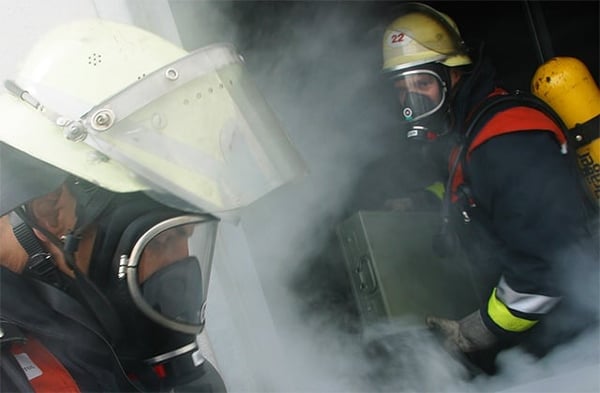
The DMO range is typically 3-5 kilometers.
In contrast, 5G has a DMO type feature called ProSe (Device Proximity Services) where devices can communicate without the network when they are very close to each other, about 100-300 meters apart.
Where TETRA radios are designed for voice, smartphones are designed for apps. This is their great advantage. However, it is possible to combine the data advantages of (professional) apps and a TETRA radio, with the Tactilon Dabat hybrid device being a prime example.
2 - How can I find a radio that is more than just a voice device?
Voice communication is vital in many jobs. Police officers, fire fighters and oil refinery workers all need quick and reliable voice communication every day. But they also need additional information, which can be delivered as data in the form of photos, maps, pictures, documents, videos, status information. Today, they use a different device or several different devices for this - not the easiest, most effective or economical way to work.
A good solution is a dual-mode TETRA+broadband device, which offers both ultra-reliable voice and broadband data.
Hand-picked content for you:
Can TETRA radios be more like the devices we use in our everyday lives? Can a smartphone cut it in the demanding world of emergency services? The answer is yes, if you opt for a smart radio that is rewriting the rules.
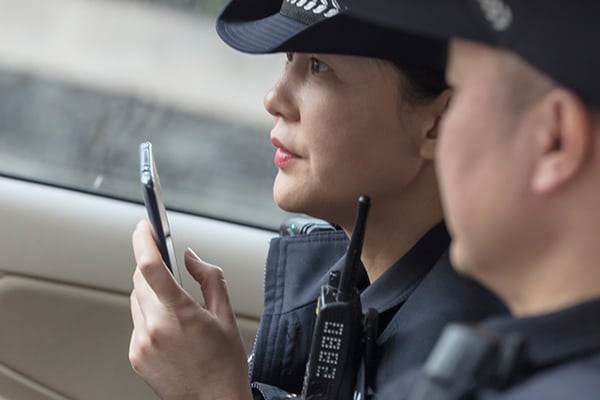
3 - How do I solve the challenge of the limited data capabilities of two-way radios?
The truth is, standard PMR radios work on technologies and frequencies that cannot deliver fast data like today’s consumer smartphones can. The only realistic way today to solve this challenge is to adopt a broadband-capable device.
When users need both a traditional radio for voice AND to take advantage of broadband, there are four options:
- Carrying two separate devices – a TETRA radio and a smartphone.
- Carrying two connected devices – a remote speaker microphone (RSM) with TETRA capability and a smartphone. The RSM would be connected to the smartphone.
- Carrying two connected devices – a smartphone with a special cover or sleeve that would have TETRA functionality. The cover or sleeve would be connected to the smartphone.
- Carrying one device – a hybrid, dual-mode device that is a TETRA radio and smartphone in one, such as Tactilon Dabat from Airbus.
4 - Can I get broadband services in a TETRA radio?
Many professionals have asked: “Can I get both 4G/5G and TETRA technology in one handset?” or similar questions.
The answer is yes, you can! Take Tactilon Dabat, for example. It is the world’s first dual mode smartphone and TETRA radio in one device. You can use it for mobile applications and special public safety apps, and as a TETRA radio for critical communications. You no longer need to carry or charge two devices with two different sets of accessories.
Tactilon Dabat is a hybrid device, designed for professionals, and it delivers all five features that are important to professionals: ease of use, excellent voice, external PTT, long battery life and ruggedness.
Find out more at: www.securelandcommunications.com/blog/five-must-have-features-of-a-hybrid-tetralte-device
5 - Can I buy a smart device that also works as a TETRA radio?
If you want a smart device that also works as a TETRA radio, the best choice is Tactilon Dabat. It may look like a regular fully rugged smartphone, but in addition to its smartphone capabilities, it offers the same functionality once found only on TETRA radios.
Tactilon Dabat can operate on any standard TETRA network on the 380–430 MHz frequency band. A physical push-to-talk button (not a fiddly screen icon) makes it easy for the user to talk to TETRA groups. The professional form factor also makes it comfortable for prolonged use. The large touchscreen is ideal for sending messages and it can be used when wearing gloves.
Another option is to adopt an application that can bring TETRA group communications in a smartphone – namely, Tactilon Agnet 800. It is an easy-to-use app that lets smartphone users contact TETRA groups at the touch of a button.
6 - Is there a device on the market that can deliver PMR over broadband?
“PMR over broadband” could also be understood as “PMR-like features over broadband” - see question 17 for more information on that. Here, we consider this question to be about TETRA and broadband services in one device.
In their work, more and more professionals use both a TETRA radio and a smartphone. But the functions of a mission-critical radio and a smartphone could be combined. Tactilon Dabat is a rugged smartphone with a TETRA radio inside - and is designed for ergonomic, push-to-talk (PTT) use even for long periods. If PTT is needed only a few times a day, an easy to hit button on the touchscreen is good enough. However, heavier use requires a physical PTT key in the right place on the device.
Tactilon Dabat, for example, has a physical PTT key that is easy to use even when wearing gloves.
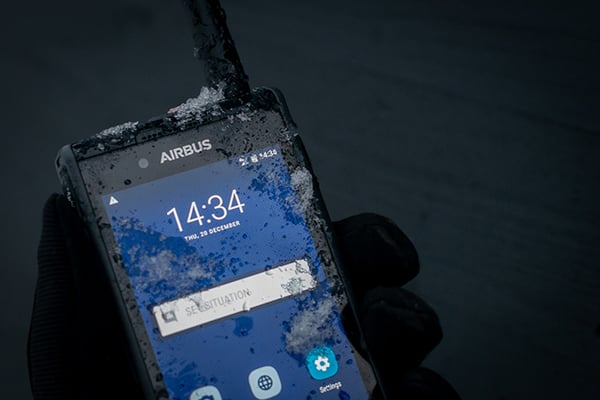
7 - What are my options if I want to carry just one device, not 3-4 different phones and radios?
Yes, it is possible to get everything in one device. But make sure this device ticks the five most important boxes: ease of use, excellent voice, external PTT, long battery life and ruggedness.
In addition to a versatile device, you also need an ecosystem that delivers professional, secure and certified applications. Otherwise, where can you get the apps you need in your everyday duties?
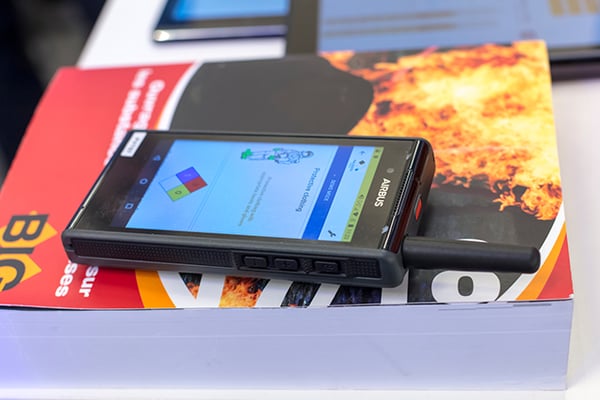
For example, consumer apps are not generally required to meet the two key needs of professional users: security and data confidentiality, and reliability.
Hand-picked content for you:
The seventh Airbus survey into the professional apps market shows that security and data confidentiality as well as reliability remain most important to survey respondents when looking for apps. Download the latest report “Professional app trends 2022 - 37 things you wish you'd known earlier”
8 - How do I get TETRA and a smartphone together in one device?
There is a growing trend of professionals using smartphones to complement TETRA radio communications in their daily tasks, to take advantage of broadband and high-resolution video, for example.
However, a TETRA radio and a smartphone do not really work well together– two different devices mean different procedures and different functions. Carrying two devices is also not ideal.
Experts from Airbus asked this question, “Should we combine TETRA radios with a smartphone?”
The answer was yes, and the solution was to bring TETRA radio functionality into a smartphone that is specially designed for professional, every day, all-the-time use. That product is Tactilon Dabat, the hybrid TETRA + broadband device.
9 - What if I want to use push-to-talk in a smartphone but not a push-to-talk app?
Push-to-talk (PTT) as a button on the touchscreen is a nice feature and quite adequate if you only need the PTT a few times a day. But if push-to-talk is needed often and all day, the user will need a real key located in just the right place on the device. Ergonomics are important – and the key must be easy to use without looking, and even with gloves on.
Such a PTT key is available on Tactilon Dabat, a device designed for ergonomic push-to-talk use with a physical PTT key.
10 - Is there a dual-mode device that provides enough security when transmitting over the open airway?
Consumer smartphones are notoriously open to attack. Consequently, many professional organizations find the use of smartphones problematic. A better choice is a professional, hybrid smartphone that can take advantage of high security features and protocols.
The dual-mode Tactilon Dabat device meets the needs of organizations that cannot compromise on security. Conforming to international recommendations, it uses the highly secure TETRA standard and best smartphone security practices.
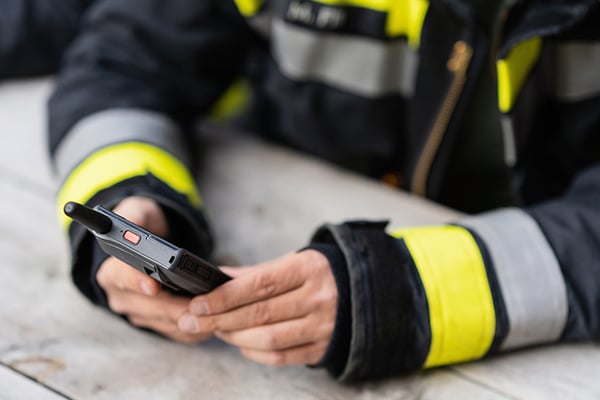
Tactilon Dabat has several threat countermeasures not usually found in other smartphones, including:
- Application control and signing for malware protection
- Secure boot prevents the device being used if bootloader is tampered with
- Enforced SE Linux mode enhances platform integrity and sandboxing since Android 6
- Control of debug features to prevent abuse of developer options when devices are in operational use
- Secure data storage: Data encryption is always on
- Secure IP communication: VPN is always on
- Secure physical interfaces by whitelisting of profiles and accessories.
In addition to a secure device, organizations must have sufficient security policies to manage applications and user access.
Hand-picked content for you:
Learn what every professional should know about the threats and risks related to smartphones - download white paper "How to manage smartphone risks for professional users"
11 - How can I transition to public safety broadband?
Today, many organizations using narrowband radio communications see mobile broadband as an effective way to boost operational efficiency, safety and security.
Adopting a hybrid network with both narrowband and broadband is a good route to success. And there are four essential topics when it comes to broadband evolution.
Let’s say you are one step further ahead. You are planning to introduce mobile broadband and mobile apps but don’t know where to start. Check these 14 videos and guides that will help you evolve your network to broadband.
The 14 helpful resources start from the very beginning: what is the best strategy for broadband evolution? There are resources that also help you start your planning. After all, PMR evolution is not a question of technology - instead, it should be a way to provide more value for users.
12 - How would DMO work in a dual TETRA+broadband device?
Today’s smartphones do not support device-to-device communications. Even with the Proximity Services (ProSe) feature, a smartphone with its tiny output power can only communicate directly with another device without the network when they are very close to each other, about 100-300 meters apart.
However, a dual-mode TETRA + broadband device – such as Tactilon Dabat - can provide Direct Mode (DMO) over TETRA. The DMO range is typically 3-5 kilometers.
13 - How would apps work in a hybrid network?
The mission critical professional world has clearly taken on board the hybrid concept for networks and devices. The three stand-out characteristics of mobile apps that professional users value most – according to the Airbus survey on mobile applications – are security and ownership of data - control in own hands; high reliability and availability of the service; and ease of use.
Because professionals value security and privacy, their applications must be tested against security threats and malware risks. Apps cannot be allowed to break the mission critical PMR voice and data, and because reliability and availability are an issue, apps cannot be allowed to drain the battery during field operations. Therefore, professional apps must be rigorously tested and certified.
Apps must also not be something separate and distinct from the features and capabilities of the professional device. Instead they must work with the device, enhancing and improving its features to bring greater efficiency and safety to users.
And this brings us to the next question.
14 - How do LTE, TETRA and applications work together in Tactilon Dabat?
Although TETRA and broadband communications are physically separated in Tactilon Dabat to ensure the highest security, the “smartphone” part of this device augments and enhances the TETRA capabilities.
One of the best examples of LTE, TETRA and an application working together is Tactilon Dabat’s Hybrid Roaming capability. With Tactilon Agnet 800, the device can automatically move from using the TETRA network to using a broadband network or vice versa. When moving outside TETRA coverage, for example, the application will seamlessly switch to the available broadband service.
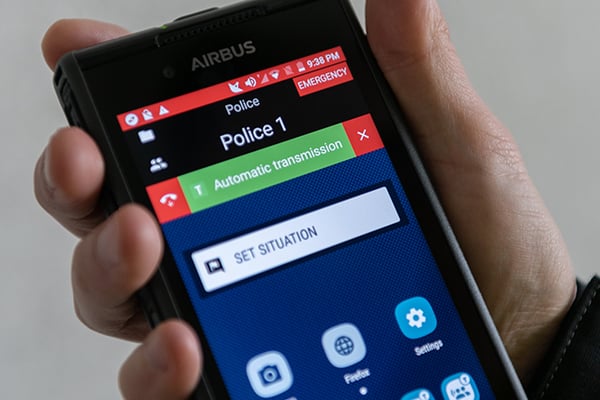
In effect, this capability increases the area in which communications are available. Also, the user does not have to think about or decide which network to use but can simply concentrate on the task in hand.
Handpicked related content:
Want to get most out of TETRA and 4G/5G? Follow this tip!
The TETRA implementation can also offer an application programming interface (API), and that members of the SmarTWISP developer programme can access. This enables SmarTWISP members to develop smartphone applications that take advantage of both the LTE/4G/5G and TETRA worlds. This is an innovative concept, unique in this industry.
Take the “Man Down” feature, for example. When the TETRA radio notices the “Man Down” situation, it can automatically send an emergency message and the exact location of the radio to the control center. People at the center can decide to send a rescue team to the location, for example.
Tactilon Dabat is a TETRA radio, so it can also initiate the emergency message, but because it is also a smartphone, it can provide much more data.
Thanks to the API, a developer can create an application that is triggered by certain events on the TETRA side. For the “Man Down” situation, for example, an application could start a video broadcast from the device camera to the control center, enabling quicker decision-making, saving time and maybe even the person’s life.
Handpicked related content:
The "Man Down" feature is very useful, but what if one could avoid the situation completely thanks to sensors giving an advance warning? Take a look at the blog post "15 things your boss expects you to know about NFC, RFID, and IoT".
15 - Where can I buy a radio that is more than just a voice device?
Tactilon Dabat is much more than just a voice device. It is both a TETRA radio and smartphone in one, complete with smartphone features and apps.
Download Tactilon Dabat’s technical specification for details on this great product.
Need more information on Tactilon Dabat? Perhaps you are interested in a demo?
Click on the button, fill in the form that opens, and we will get back to you. The details you give will help us prepare for our next interaction.
16 - How can I make sure the hybrid device is a future-proof investment?
A good hybrid device will have its smartphone side, but it will also work in your existing TETRA network. Not having to choose between them makes it a future-proof investment.
Firstly, the current operational models are based on communications that run on top of the existing TETRA network. People can use the TETRA side of the hybrid device and work the same way as before.
Secondly, a proper hybrid device allows people to take advantage of additional possibilities thanks to the smartphone side. In other words, they do not have to start by developing completely new operational models – they can make valuable improvements with minor changes on top of the existing ways of working.
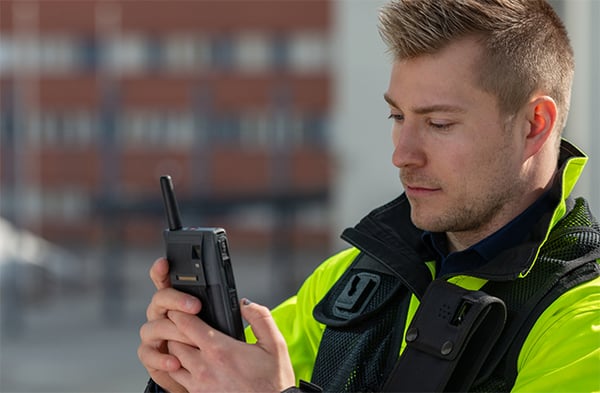
You can benefit from investments you’ve already made in TETRA, and you don’t have to throw out the chance of adopting broadband solutions. You can use TETRA and LTE/4G/5G together, getting new multimedia services and professional apps into use sooner and more securely.
Data plays an increasingly important role in the future of mission critical and business critical communications. Better information can help professionals make better decisions and help them be more efficient. A device which supports both reliable voice communication and modern smartphone data applications should be a professional’s main tool in the future.
17 - Can I get PMR over broadband?
This question sounds easy but is not so simple to answer. Does the question refer to PMR in general or TETRA in particular, for example?
If we look at features, there are four that are key to PMR systems and which have not been available in commercial mobile networks until very recently.
- Group communications (also called point to multi-point communications). This means that a person can use the mobile device to communicate with a group or team of people without calling them separately or adding them into a call one by one.
- Push-to-talk (and release to listen). This means that a single button or key on the device opens communications. No dialing is needed, and there is a near-instant connection.
- Large coverage areas. Public safety networks have been built to provide coverage in areas where commercial mobile networks do not necessarily reach.
- Closed user groups. This means that people can communicate only in pre-defined groups (or teams). In addition, only authorized devices can communicate in the network in general, and communications are encrypted and cannot be eavesdropped.
Looking at the four key features or ways of operation, group communications and push-to-talk are widely available in a variety of push-to-talk apps.
But, what about the third feature? Commercial networks cover large areas, yes, but what if the network is not available? A regular smartphone does not support device-to-device communications, but a dual-mode device will provide Direct Mode (DMO) over TETRA. Even with the Proximity Services feature, a smartphone with its tiny output power can communicate directly with another device, without the network, only when they are very close to each other, about 100-300 meters apart.
Closed user groups and the confidentiality of communications are not as easily delivered either, particularly in off-the-shelf push-to-talk apps.
In other words, broadband-only solutions cannot yet deliver the four most important features of a traditional PMR system.
So how about TETRA over LTE/4G/5G, then? This blog post explains what “TETRA over LTE” means.
When TETRA radio users and their smartphone-carrying colleagues need to communicate with each other, an app is needed that can connect the smartphone users to TETRA groups. The blog post “TETRA and your smartphone – it’s a marriage made in heaven” explains how it is possible – provided you use an Airbus TETRA network and a special application called Tactilon Agnet. With Tactilon Agnet on their smartphones, staff can also communicate with the control room and from outside TETRA network coverage, provided the broadband network is available.
More questions?
TETRA and LTE/4G/5G are extremely useful technologies but until now they have been difficult to marry together into one complete solution that takes advantage of them both. With the advent of Tactilon Dabat, this has all changed.
Much more than just a voice device, Tactilon Dabat offers both a TETRA radio and smartphone in one, complete with smartphone features and apps. Many of the questions above can be summed up by ‘How can I combine secure, rugged professional radios with the great features of consumer apps?’ and Tactilon Dabat is the ultimate answer.
I hope that the above Q&As have given you a better insight into hybrid devices and their capabilities. But if you have any more questions, please let us know:
This blog post was originally published in June 2019. It was edited in April 2022 to include the latest information.







